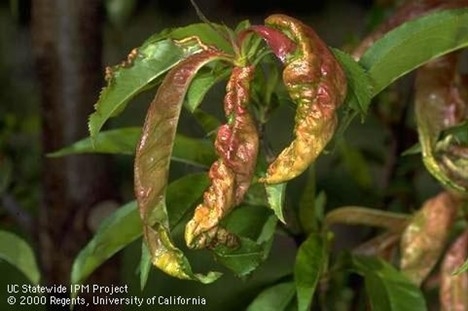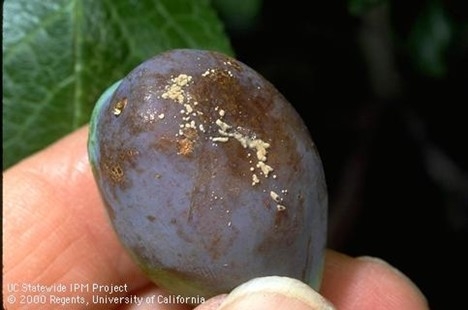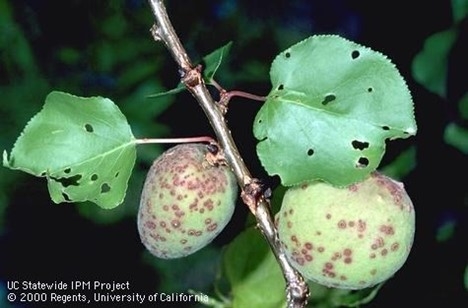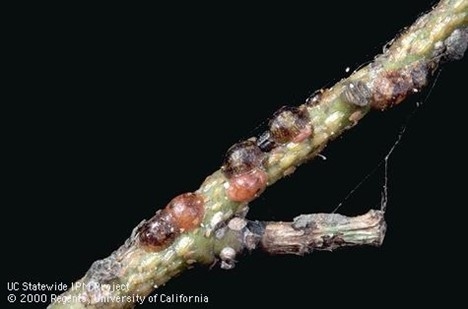Is it Time to Use Dormant Sprays on Your Backyard Fruit Trees?
This year was particularly bad for peach leaf curl and other fungal infections in fruit trees because of the wonderful rain we had last winter and spring. It looks like we might have another wet winter, so we are rerunning this post to remind you to think about a spray program for your trees.
Now that the leaves have fallen, or mostly fallen, from your backyard fruit trees, are you wondering whether you should apply dormant sprays?
“Dormant sprays” or “delayed dormant sprays” are terms used for the application of pesticides when the tree is dormant or just coming into bud swell. The pesticide could be a fungicide used to help manage fungal disease or a horticultural oil or oil in combination with insecticides to kill insects.
Don't assume that you need dormant spray. Before reaching for the spray, first determine whether your trees have previously had a disease or serious insect pest problem that can be managed with dormant sprays. Have you already tried all non-chemical recommendations for lessening the problem? Finally, evaluate the amount of damage from the disease or insect pest you experienced in the prior growing season to decide whether a pesticide is really needed.
Fruit tree diseases that can be managed by applying a fungicide dormant spray include peach leaf curl, brown rot, and shot hole disease.
Peach Leaf Curl
Peach leaf curl affects only peach and nectarine trees. It shows up in spring after the tree has leafed out. Leaves are thickened, curled, and colored red or yellow instead of normal green.
If your tree has had significant peach leaf curl in prior years, dormant spraying with a fixed copper spray just after all the leaves have fallen from the tree (usually December to January in our County) may prevent or reduce the severity of the disease. For information on managing peach leaf curl, see https://ipm.ucanr.edu/PMG/PESTNOTES/pn7426.html/
Brown Rot
Brown rot (Monilinia) is a fungal disease that can affect peaches, plum, cherries, apricots, and nectarines. In the spring blossoms on infected trees shrivel and die, often clinging to the twigs. Leaves at the base of infected twigs may also turn brown and die. Fungal spores attach themselves to developing fruit and show up as brown or tan spots on the surface of the fruit.
If your trees had significant fruit loss from brown rot in the prior growing season, a dormant spray of a copper-based fungicide may help. Apply it at the pink bud stage while flower buds are still tightly curled and pink in color. For more information on brown rot, see http://ipm.ucanr.edu/PMG/GARDEN/FRUIT/DISEASE/aprbrownrot.html.
Shot Hole
Shot hole (Coryneum blight) can affect plums, nectarines, peaches, cherries, and especially apricots. It shows up as small reddish holes on leaf surfaces. Often the holes turn brown and drop out. Fruits may also be infected. Where disease has been severe and cultural steps haven't helped, a fungicide spray following complete leaf drop may be needed. See http://ipm.ucanr.edu/PMG/GARDEN/FRUIT/DISEASE/shothole.html.
Brown Soft Scale
Insects that can be managed with dormant sprays of horticultural oils or oils mixed with insecticides include scale, aphids, and spider mites. Don't spray unless you have confirmed that the insects are present in damaging numbers and cannot be controlled by other means. Keep in mind that spraying may also kill beneficial insects which are the first line of defense against insect pests.
More information on controlling these insect pests can be found at these UC websites: https://ipm.ucanr.edu/QT/scalescard.html
https://ipm.ucanr.edu/QT/aphidscard.html
https://ipm.ucanr.edu/QT/spidermitescard.html
Caution: Before spraying, read and carefully follow the label instructions on the pesticides you use, including wearing recommended protective gear.
Help Desk of UC Master Gardener Program of Contra Costa County (TKL)



